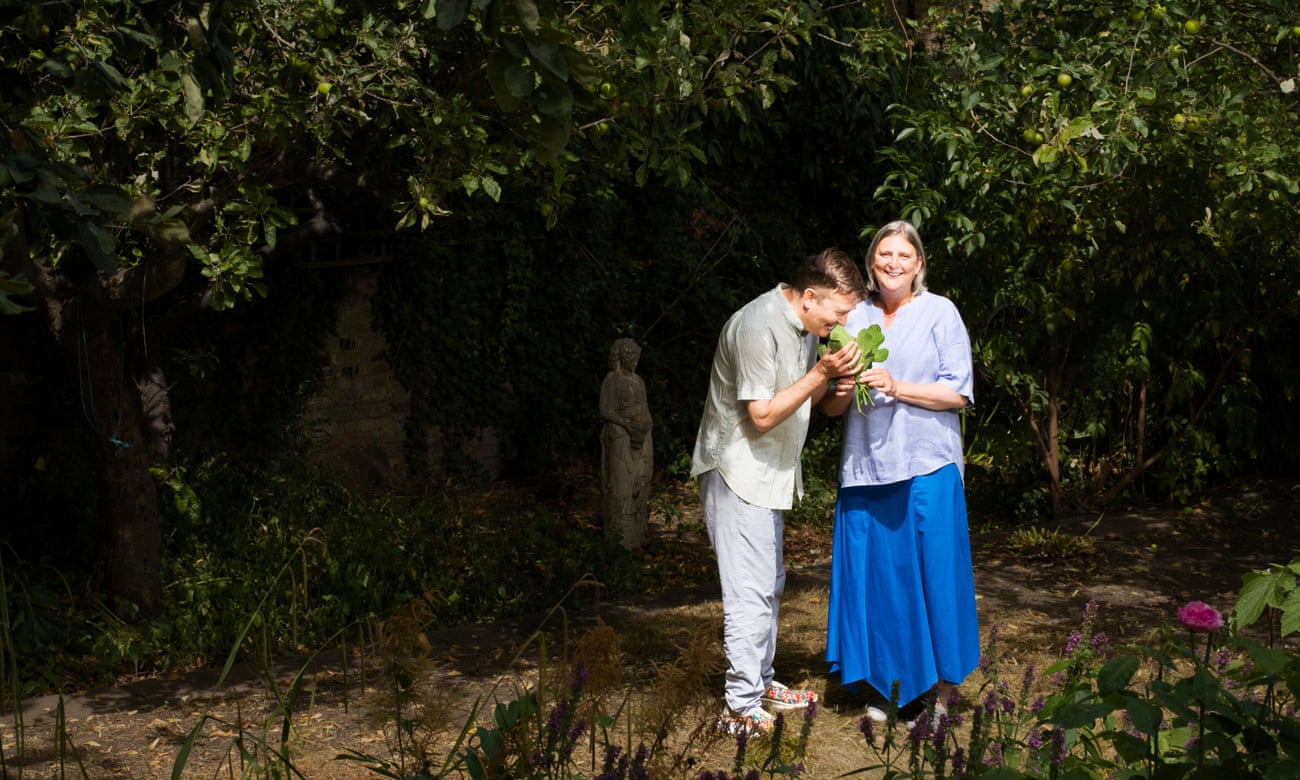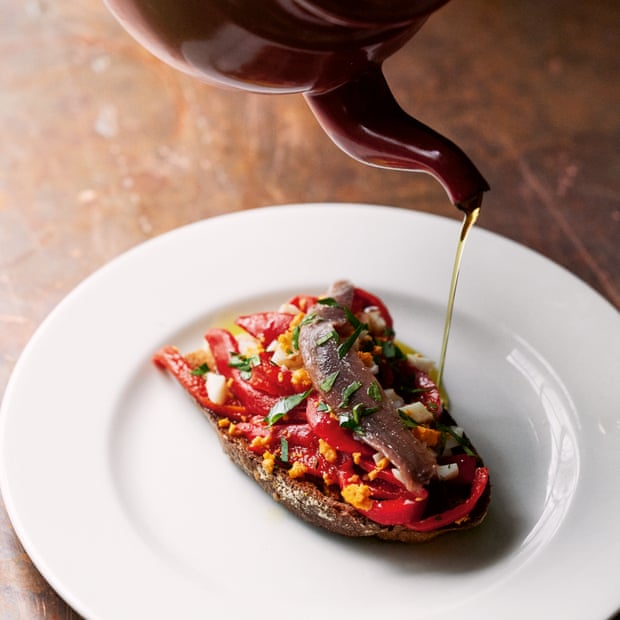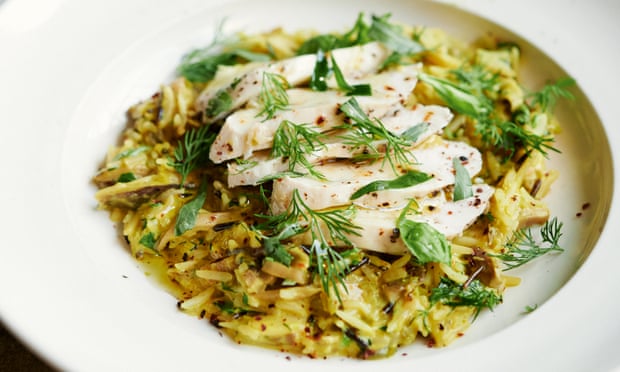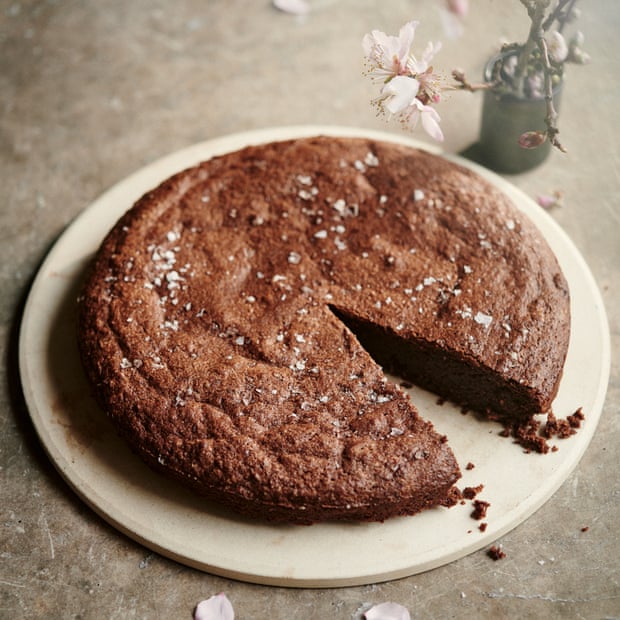
Everyone loves toast. But there is toast and… toast. In Moro Easy, a new cookbook by Sam and Sam Clark, there are no fewer than 10 recipes for things on toast. Some are straightforward, almost austere: I can’t imagine the person who wouldn’t be able to rustle up a few slices of their tomato and jamon toast (the secret lies with a grater and just the right amount of garlic). Others are luxuriant: imagine a crisp oval of sourdough topped with a thin tortilla and aioli – a breakfast treat they first ate in Barcelona’s Boqueria market – or with crab warmed in butter and Oloroso sherry and lightly seasoned with fresh chilli and thyme.
Moro Easy is the Clarks’ first book since 2014 and it is, at least in part, a result of the pandemic: their London restaurants – Moro in Clerkenwell and Morito in Hackney – suddenly shuttered, the pair found themselves unexpectedly at home with their three children (running a delivery service, they decided, was not for them). “It was extraordinary,” says the first Sam (to avoid confusion, I will hereafter refer to her husband as Samuel), “cooking three meals a day for five, rather than however many covers in the restaurant.” Some of the ideas that eventually went into Moro Easy were old ones, reworked for the home cook. But others were born of this period, when they were cooking off the cuff. “We felt a bit smug,” says Samuel. “At the supermarkets, there were long queues. But our local shops had no queues, and they sell everything you could want. I loved having the time to shop. We’ve lived here for 15 years, and I’d never really used the high street before.”
At their kitchen table, half of it these days dotted with pots of geraniums, we turn the pages of Moro Easy. Samuel alights on a recipe for spiced labneh with sun-dried tomatoes, coriander and fennel seeds, about which, it turns out, they both have a couple of things to say. First, they tell me, making your own labneh – a strained yoghurt with the consistency of soft cheese, used in Middle Eastern cooking – is both easy and a “revelation” (using Greek yoghurt and cream cheese avoids the need for straining). Second, sun-dried tomatoes are due for a comeback. “The backlash was unnecessarily harsh,” says Samuel with a smile. There follows – more page turning – some talk of rice (the Clarks are self-confessed rice snobs), pistachios (the best come from Turkey), chicken livers (why do they make people nervous?) and ice-cream (Moro Easy includes a recipe for one flavoured with coffee and cardamom that, involving no churning, takes mere seconds to whizz up).
The Clarks’ first book – Moro, the Cookbook – came out in 2001, four years after their influential restaurant, its menu inspired by their travels in north Africa and the eastern Mediterranean, opened in 1997; instantly hailed as a classic by Nigella Lawson and Claudia Roden, it remains much loved (though they’ve since published several more). Is it hard to write in its shadow? “It’s good having a bit of distance between the books,” says Sam. “But, though we’re proud of the first one, we’ve never quite been able to understand its success. The other books have recipes that are just as good. It kind of became part of the culture for a while, didn’t it?”
In the end, they measure themselves only by their own standards, in the restaurant as well as when it comes to writing: “Within the first two years of Moro opening, we were approached to sell the brand. We just said: no, no, no, we’re here to stay. We’re the cooks, and we like doing that, and it’s what we’re here for – and we’ve stayed true to it. We’re still in the kitchen now. We’re in it for the long haul.”
Post-pandemic, it was difficult to get things fully up and running again; restaurants are about momentum. “But then we’d have customers coming up to the pass and literally crying, they were so happy we were open again,” says Sam. “That’s what all the hard work is for.” But what about their relationship? If running a celebrated restaurant for 25 years is a huge achievement – restaurants in London change more often than the weather – it is surely a miracle that they’ve done so without winding up in the divorce courts (they met when they were both working at the Eagle, just down the road from Moro, in Clerkenwell). “Well, I got told off the other day, didn’t I?” says Sam. Samuel takes up the story. “She was late, and I had a new chef to settle in, and I was doing a hot section myself, and we had a lot of people booked.”
What happened? Was there an explosive row? Apparently not. “I just worked twice as hard,” says Sam. For the team, some of whom have been at Moro for a long time, this kind of thing usually passes – according to Samuel – as light entertainment: “There can be a slightly comical hissing at one another.” In the end, though, they tend not to let things simmer. Marital stew, it seems, is one dish best removed from the heat as soon as possible.
Fish tagine with potatoes, peas and coriander (pictured above)
The subtle use of mixed spices and preserved lemon gives a distinctive flavour to this Moroccan fish stew.
Serves 4
olive oil 3 tbsp, plus a little extra for drizzling
banana shallots 2, or 1 small red onion, peeled
garlic 2 cloves, peeled
preserved lemon rind 1 heaped tbsp, finely chopped (optional)
ground cumin 1½ heaped tsp
paprika ½ tsp
fresh coriander 2 tbsp, finely chopped, plus a few leaves for garnish
cherry tomatoes 200g
small waxy new potatoes 200g, such as charlotte, jersey or ratte, sliced into ½cm rounds
frozen petit pois or garden peas 200g
firm white fish 4 fillets, such as sea bass, monkfish or cod
lemon 1 slice, to serve
Using a hand blender or food processor, blitz everything except the potatoes, peas and fish. Season with salt and pepper. Transfer to a wide, deep pan with a tight-fitting lid, add the potatoes and put over a medium to high heat. Bring to a simmer, pop the lid on and cook for 5 minutes.
Add the peas and fish, replace the lid and cook for 5-8 minutes, until just cooked through. Remove from the heat, turn the fish and leave to rest for 5 minutes.
Check for seasoning and serve immediately with a drizzle of olive oil, and with the extra coriander and a slice of lemon on top.
Fried potatoes with za’atar, peppers and feta

We love the texture of the creamy, soft and salty feta gently melting into the potatoes as they are tossed together. You can see how it is a versatile accompaniment to fish and meat dishes. Also delicious with a simple tomato and basil salad.
Serves 4
roasting potatoes 1kg, such as maris piper, peeled and cut into quarters or sixths, depending on size
olive oil 2 tbsp
butter 50g
garlic 3 cloves, finely chopped
za’atar 1 heaped tbsp
spring onions 4, white and green parts, thinly sliced
fresh coriander 2 tbsp, chopped
piquillo peppers 150g (or any other roast peppers from a jar), drained and sliced into thin strips
feta 75g, crumbled
Boil the potatoes in salted water for 7-10 minutes, until just tender, then drain in a colander and spread out to dry and cool. Rough up the edges of the potatoes with a fork.
Put the olive oil and butter into a large frying pan (30cm) over a medium heat, and when the butter starts to foam, add the garlic and fry gently for a minute until very lightly golden. Add the potatoes to the pan and stir well. Season with a little more salt and pepper, then fry gently for 10-15 minutes, turning occasionally and taking care the garlic doesn’t burn, until golden and crisp on all sides.
Remove the pan from the heat and transfer the potatoes to a dish. Sprinkle over the za’atar, spring onions, coriander and peppers, and toss gently.
Finally crumble over the feta, toss once more, check for seasoning and serve.
Spinach, pine nuts and sultanas

For a more substantial meal, serve this on toast with a dollop of soft goat’s cheese on top to melt into the warm, sweet spinach. This recipe is endlessly compatible.
Serves 4
spinach 1kg, washed and drained
olive oil 4 tbsp
banana shallots 2 (120g), very finely chopped
garlic 1 clove, finely chopped
dried oregano ½ tsp, or 1 tsp finely chopped fresh oregano
pine nuts 5 tbsp, lightly toasted
sultanas 5 tbsp
soft goat’s cheese 100-150g (optional)
toast (optional)
Wilt the washed spinach in a wide dry pan (30cm) in two to three batches over a medium heat. When soft, transfer to a colander to drain and cool. Squeeze out any excess water and roughly chop.
Rinse the pan quickly, then return to the heat and add the olive oil. Once hot, add the shallots, garlic, oregano and a pinch of salt. Fry for 8-10 minutes, stirring occasionally, until soft and caramelised. Add the pine nuts and sultanas, then fry for a minute. Add the spinach, stir to warm through.
Check for seasoning and serve, either as it is or on toast with some goat’s cheese.
Pepper, anchovy and chopped egg

The marriage of the sweet peppers, salty anchovies and creamy egg make this toast a visual and taste sensation.
Serves 4
roasted piquillo peppers 6-8, from a jar, or 2 romano peppers (180g), roasted until soft, then peeled and deseeded
good-quality red wine vinegar ½ tbsp, plus a pinch of sugar if not sweet
extra virgin olive oil 4 tbsp
sourdough bread 8 slices or 4 slices ciabatta (if ciabatta, use slices 8cm wide, cut in half horizontally)
garlic ½ clove
egg 1 organic or free-range, hard-boiled and finely chopped
best-quality anchovy fillets in olive oil 8 (we use Ortiz)
flat-leaf parsley 2 tbsp, finely chopped
Cut the peppers into strips and mix with the vinegar, olive oil, salt and pepper.
Toast the bread, brush the cut side of the garlic over the hot toast, then spoon the peppers on top, followed by the chopped egg and anchovy fillets. Finish with the chopped parsley.
Roast chicken, wild rice, mushrooms and sweet herbs

The addition of turmeric brightens the overall look of this recipe.
Serves 4
olive oil 2 tbsp
butter 25g
leeks 2, white part only, cut in half lengthways and thinly sliced
bay leaves 2
mixed mushrooms 400g (field, wild and oyster), sliced
mixed wild and basmati rice 200g
vegetable or chicken stock 400ml
organic chicken breasts 4, skin removed
Greek yoghurt 200g, seasoned with ½ garlic clove crushed with salt and 1 level tsp turmeric
tarragon, dill, parsley and basil 3 tbsp each, chopped
Aleppo chilli flakes ½ tsp
Preheat the oven to 180C fan/gas mark 6.
Place a large (30cm) heavy ovenproof casserole pan with a tight-fitting lid over a medium heat, and add the oil and butter. When the butter begins to foam, add the leeks and bay leaves and a good pinch of salt, and fry for 10 minutes or until the leeks are soft and sweet, stirring occasionally.
Add the mushrooms and continue to cook, stirring occasionally, until the mushrooms are soft and their liquid has almost evaporated (about 5 minutes). Stir in the rice and the stock and bring to a gentle simmer.
Lay the chicken on top, season with salt and pepper and cover with the lid. Place in the oven for 20 minutes, then remove the lid and continue cooking for another 5-10 minutes, until the rice is cooked and the chicken is cooked through (juices run clear).
Remove from the oven and lift out the chicken to rest for a couple of minutes. Stir the yoghurt mixture and ⅔ of the sweet herbs into the rice. Slice the chicken and serve with the rest of the herbs on top and sprinkled with chilli flakes.
Chocolate almond cake

My friend Sara Fanelli baked this gluten-free cake for us. We love it, especially with a little sea salt sprinkled on top.
Makes 1 cake, serving 8-10 slices
dark chocolate 175g, broken into chunks
unsalted butter 175g, plus extra for greasing
caster sugar 175g
ground almonds 175g
free-range or organic eggs 4, separated
sea salt
Preheat the oven to 140C fan/gas mark 3.
Generously grease a 23cm cake tin with butter and line the base with baking paper.
Put the chunks of chocolate into a bain-marie (a heatproof bowl set over barely simmering water). Once melted, remove from the heat and stir in the butter to melt. Stir in the caster sugar, ground almonds and a small pinch of sea salt.
Set aside to cool slightly. Meanwhile, whisk the egg whites to soft, fluffy peaks.
Once the chocolate mixture has cooled slightly, stir in the egg yolks. Using a metal spoon, stir in one heaped spoonful of the whisked egg whites. Once this spoonful is fully incorporated, gently fold in the remaining egg whites.
Gently pour the batter into the prepared cake tin and lightly sprinkle the top with flaky sea salt.
Bake for 40-45 minutes, until the top is crackled and the cake feels slightly springy to the touch.
Allow to cool in the tin before removing and placing on a wire rack. Cut into slices to serve.
Moro Easy by Samantha Clark & Samuel Clark (Ebury Publishing, £30). To support The Guardian and Observer, order your copy at guardianbookshop.com. Delivery charges may apply
The Observer aims to publish recipes for sustainable fish. Check ratings in your region: UK; Australia; US



